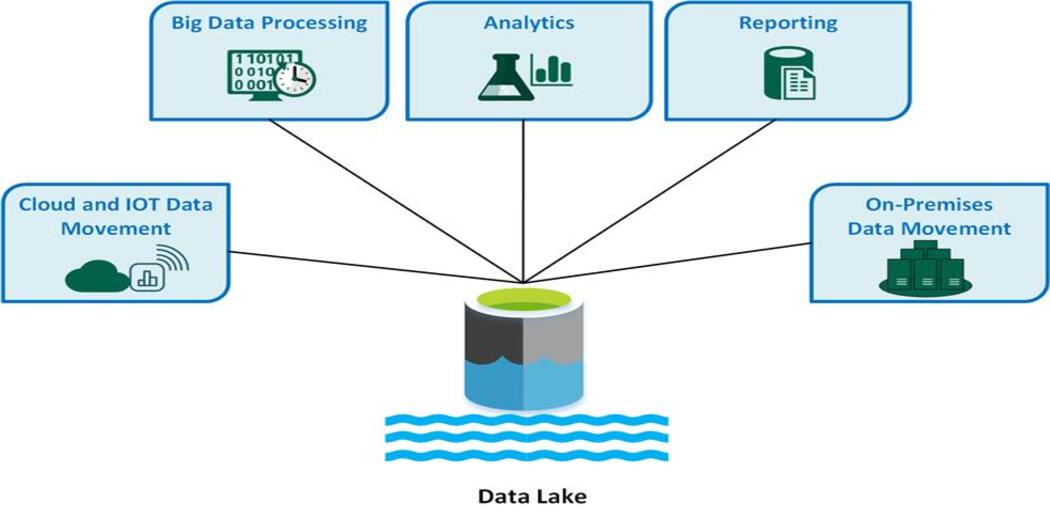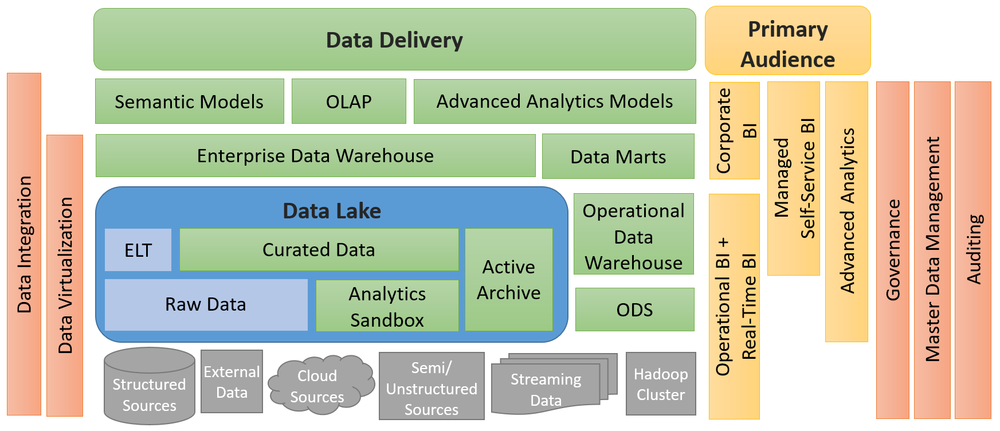This article was published as a part of the Data Science Blogathon.
Introduction
Today, Data Lake is most commonly used to describe an ecosystem of IT tools and processes (infrastructure as a service, software as a service, etc.) that work together to make processing and storing large volumes of data easy. An ecosystem consists of several key components, including software tools and processes that store and process data; IoT (Internet of Things) connected devices that store, and process data about users and products; storage system providers, data integrator partners (Microsoft Azure Data Lake Software Gateway), (software tools like Greenplum Realtime Report and hardware platforms like VMware vRealize Automation)

What is a Data Lake?
It is a data storage and analysis platform that stores and analyzes large amounts of data. Data lakes are typically used to store, analyze, and visualize large amounts of data from various sources, such as weblogs, email archives, social media feeds, etc. The purpose of a data lake is to store and analyze large amounts of data in a centralized location. A data lake can be created using several technologies, including databases, NoSQL databases, and cloud storage. A data lake can be used to store all the data generated by an organization’s systems, from sales transactions to employee performance evaluations. A data lake allows for analysis and easy access by storing all data in one place.
While creating a data lake, it is important to remember that the data lake should only be used to store the most important data. This is because the more data is stored in a data lake, the more likely it is to be deleted or lost.
Why Data Lakes?
It is a data storage system that stores all the data generated by an organization. A data lake is usually a collection of databases, but it can also include other data types, such as images, videos, and other file types. Apart from storing all the data an organization generates, a data lake can also be used to analyze data and predict future trends.
The purpose of a data lake is to store all the data generated by an organization. This allows the organization to access all data anytime and make decisions based on the data. The benefits of a data lake include quick access to all data and data-driven decision-making. A data lake allows a large amount of storage to store data from data sources.
The following reasons for building a Data Lake are:
- Company data is stored in various systems, including ERP platforms, CRM applications, marketing applications, etc. It helps to organize the data on these platforms. However, there are times when it is necessary to consolidate all the data into one place to analyze all the attribution and data journey. Using Data Lake Architecture, a single organization can gain a general view of data and generate insights.
- It allows businesses to store data and use it directly from BI tools without having to worry about accessing transactional APIs. Enterprises use enterprise platforms to run daily tasks that provide transactional API access to data. It allows businesses to store and use data directly from BI tools. With ELT, you can quickly load data into the Data Lake and use it with other software tools using a flexible, reliable, and fast method.
- The performance of a particular application may be affected by data sources that do not offer faster query processing. The data aggregation process requires a higher query speed, which depends on the data’s nature and database type. The Architecture enables fast querying by providing a Data Lake infrastructure that supports fast query processing. Data Lakes can be scaled up and down quickly, making them easy to query.
- Before moving on to the next stages, having the data in one place is important because loading data from one source makes it easier to work with BI tools. This makes your data cleaner and error-free, reducing the possibility of data duplication.
The Architecture of Data Lakes
The main components of a data lake architecture are shown in the figure below. All key technologies are part of the ecosystem. All ETL tools transform the data into a structured or unstructured form, the data warehouse stores the data for long-term storage, and the expert solves queries against the data warehouse to get the final result.

Source: learn.microsoft.com
This Architecture is a step-by-step process that guides an organization in designing and maintaining a data lake. Data lakes allow organizations to retain much of the work typically invested in creating the data structure. These are some of the primary aspects of a robust and effective Data Lake Architectural model:
- It is important to monitor and oversee data lake operations to measure performance and improve the data lake through monitoring and oversight.
- Security must be a key consideration when approaching the initial phase of architecture. This is different from relational database security.
- Data that is associated with metadata is referred to as metadata. For example, reload intervals, structures, etc.
- One organization can have multiple admin roles. Individuals who hold these roles are called administrators.
- It is important to monitor and control ELT processes to perform raw data transformations before they reach the clean space and application layer.
Key Components of the Architecture
It is an ecosystem where key elements work together to make storing and analyzing large volumes of structured data Easy. There are different data lakes, including hybrid, public, and private. The public data lake is open to anyone to use. The private data lake is only available to those with the necessary security credentials. A hybrid data lake contains data from the organization. It is most likely owned by the marketing team, although it will be accessible to all business units in their corporate copy. An organization should define its data lake structure based on the following concept.
A data lake typically includes five divisions:
Ingest Layer: The ingest layer of the Data Lake architecture is responsible for capturing raw data and transforming it into data inside the data lake. Raw data is not changed in this layer. The receiving layer is the first and foremost in the data pipeline, where data is captured and processed. Depending on the application’s requirements, a layer can be either front-end or back-end. When data is processed, the information must be transformed into something the application requires. For example, social media platforms must transform raw social media data into marketing content, and wearables must transform data into sensor data so that it can be used to improve the user experience.
Distillation Layer: This layer of the Data Lake architecture is responsible for transforming structured data into an ingestible form at the ingest layer. The process of data transformation is also known as cleansing or cleaning data to meet certain compliance, regulatory, or business needs. The data can be easily processed. It is formatted and made ready for business users to work with. The data transformation process must be able to transform data meaningfully for business users. Data transformation is an iterative process; the first stage is data collection.
Processing Layer: The Data Lake Architect first lays the groundwork by designing the architecture of the data stores and the analytics tools that will process them. Then the Data Lake architect determines which parts of the information system will perform the most complex analytical queries and sets up a logical data structure. Query and analysis tools are used to transform structured data into actionable information. The data management process manages the data, and the analysis process analyzes the data. To consume data, it is extracted and put into the form needed for the analytics process. Data is checked and then loaded into the appropriate tables. The audit process validates the data and then records the changes in the audit process. The analytical process uses verified data to achieve the desired results. After the process is complete, the data is permanently deleted from the systems, and the systems are rebooted as needed to maintain the desired state.
Insights Layer: Data is stored in a database and made available through various data sources. The Data Lake query interface retrieves data from the Data Lake. SQL and NoSQL queries are used to retrieve data from the Data Lake. Business users are normally allowed to use the data if they wish. Once the data is retrieved from the Data Lake, it is the same layer that displays it to the user. When presented in this flat analytical format, it can also be difficult to understand the data. The Visualizations and graphs allow users to understand data more visually and can be useful in conveying complex data trends and facts. Dashboards and reports can provide users with an overview of the state of a company’s data architecture and the efficiency with which queries are being processed. They can also monitor service or application usage and identify bottlenecks.
The Unified Operations Layer: The workflow management layer is responsible for auditing and monitoring the performance of the various systems in the data lake. This collects, processes, and stores the results in a data lake. The data lake also has an audit layer that monitors the health of the data lake and studies the performance of the various systems in the data lake. It collects data, analyzes, processes it, the results to study the state of the data lake, and creates reports that help in the decision-making process. In addition to data management, the important functions of the workflow management layer are system and data profiling, data profiling, and data quality assurance. The Sandboxes are an open-ended data analysis environment where scientists can experiment with new data, explore relationships between datasets, and validate predictions using historical data. It can model complex real-world phenomena, such as climate change, disease epidemics, or economic cycles. It can be used to solve business problems by providing space for data scientists to test new models and gather feedback.
Challenges of Data Lakes
With so many players in today’s market, it is hard to make informed decisions while building a data lake ecosystem. This will lead to a data lake with unfinished features and limited scalability. Additionally, dependencies and interoperability between parts are challenging with so many different technologies and tools being used in the data lake ecosystem. This can lead to inconsistencies and inaccuracies in the data.
The following are issues that affect the design, development, and use of Data Lakes:
- Data lakes are great for data storage. However, they are not so great at data management. As data sets grow, keeping track of data security and privacy becomes difficult. Data governance, a set of best practices for managing the data we collect and how it is used, is often ignored. It is the process of planning, creating, and maintaining a set of practices for managing your data. Data management is important, but it’s not something you can do on the fly. It’s something you have to plan and execute. Data management is a process, not an event.
- New members may not be familiar with tools and services and require an explanation. The company will need to train new members to use the tools and services as the process progresses.
- If you are using a third-party data source and want to integrate it into your Data Lake, you will need to get the data from the source and then convert it into a format that your Data Lake Engine can handle. This can create a problem if your source does not support receiving large amounts of data simultaneously. If the source doesn’t support importing large amounts of data into your Data Lake, it’s a good idea to consider using tools to help with this task, such as Google Cloud Dataflow.
- Data Lakes is not a one-time solution. They require ongoing investment in data management systems and personnel. A Data Lake business must also have a process to identify and eliminate duplicate data. Monitoring the Data Lake regularly is also essential to ensure it is not drying up. Finally, a Data Lake enterprise must have a process to scale the platform as needed to ensure that the company’s data is not stored in an underutilized or unsecured solution. They require the business to invest in the process.
Conclusion
A data lake is a great way for organizations to collect and store structured data. It’s a way to centralize all your data and make it available across your organization. It can be used as a host device for other types of data, a work area for data analysis, or to house non-technical personnel who might assist with data analysis. A data lake is not only a good way to collect structured data but can also be used to store unstructured data such as images, videos, financial data, etc. It is important to remember that data lakes are not just about data; they are about an ecosystem of technologies and processes which work together.
- The Architecture enables fast querying by providing a Data Lake infrastructure that supports fast query processing. Data Lakes can be scaled up and down quickly, making them easy to query.
- A hybrid data lake contains data from the organization. It is most likely owned by the marketing team, although it will be accessible to all business units in their corporate copy.
- Data lakes are great for data storage. However, they are not so great at data management. As data sets grow, keeping track of data security and privacy becomes difficult. Data governance is a set of best practices for managing our data.
- Depending on the application’s requirements, a layer can be either front-end or back-end. When data is processed, the information must be transformed into something the application requires.
The media shown in this article is not owned by Analytics Vidhya and is used at the Author’s discretion.




